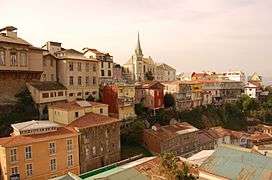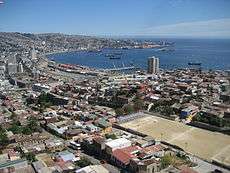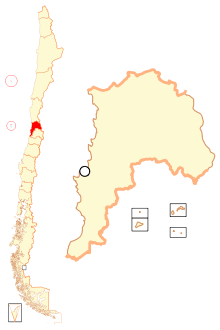Valparaíso Region
| Valparaíso Region V Región de Valparaíso | |||
|---|---|---|---|
| Region of Chile | |||
 | |||
| |||
.svg.png) Map of Valparaíso Region | |||
| Country |
| ||
| Capital | Valparaíso | ||
| Provinces |
Petorca, Los Andes, San Felipe de Aconcagua, Quillota, Quilpué, Valparaíso, San Antonio, | ||
| Government | |||
| • Intendant | Gabriel Aldoney (PS) | ||
| Area[1] | |||
| • Total | 16,396.1 km2 (6,330.6 sq mi) | ||
| Area rank | 13 | ||
| Lowest elevation | 0 m (0 ft) | ||
| Population (2012 census)[1] | |||
| • Total | 1,697,581 | ||
| • Rank | 3 | ||
| • Density | 100/km2 (270/sq mi) | ||
| ISO 3166 code | CL-VS | ||
| Website | Official website (Spanish) | ||


The V Valparaíso Region (Spanish pronunciation: [balpaɾaˈiso], Spanish: V Región de Valparaíso) is one of Chile's 15 first order administrative divisions.[FN 1] With the country's third highest population of 1,539,852 million in 2002 and third smallest area of 16,396.1 km2 (6,331 sq mi), the region is Chile's second most densely populated after the Santiago Metropolitan Region to the southeast.[1]
Its capital is the port city of Valparaíso, other important cities include Viña del Mar, Quillota, Quilpué and Villa Alemana.
Geography and natural features
The region is on the same latitude as the Santiago Metropolitan Region. Its capital is Valparaíso, which is the site for the National Congress of Chile and an important commercial port. Also in this region is the top resort city of Viña del Mar. Additionally, the Pacific islands of Easter Island (Isla de Pascua), Isla Salas y Gómez, the Juan Fernández Islands and the Desventuradas Islands fall under the Valparaíso Region's administration.
The Valparaíso Region is part of the very restricted range of the endangered Chilean Wine Palm, Jubaea chilensis; in prehistoric times this endemic Chilean tree had a significantly larger range.[FN 2]
Demographics
The Region of Valparaíso is populated by some 1.71 million inhabitants. The population density reached 94.1 inhabitants/km². 91.6% of the population lives in urban areas and only 8.4% of the population lives in rural areas.
The most populous municipalities in the region are Valparaíso, with 308,000 inhabitants Viña del Mar, with 287,000 inhabitants, which together with Villa Alemana, Quilpué and Concón form the Gran Valparaíso a continuum of 1.75 million people. There are also Quillota, with about 201,000 inhabitants and San Antonio with more than 200,000 inhabitants with estimates at 250,000 to be the region's second largest city . Soon will be added as a city with large population: the planned city of El Communa del Andes since they will be brought more than 40,000 miners required for the expansion of the mine Codelco Chile Andina Division on the foot of the Andes mountains.
Immigration and culture
Valparaíso developed as a trans-oceanic rest stop for fishing ships, sea cruise-liners and international naval ships. Therefore, a large proportion of residents have a variety of national origins, ethnic groups and cultures. The 16th-century foundation were by settlers of Andalusia, Asturia and León regions, and the most numerous Basque people of northern Spain. Large numbers came from other countries of Latin America from Mexico to Uruguay, esp. came during colonial rule in the 17th century. And in the late 18th–early 19th centuries came a small wave of Galician settlers from the Spanish region of Galiza.
It is thought the majority of Valparaíso's people have non-Spanish European background, such as: British and Irish, Australians and New Zealanders, North Americans (U.S. or Canadian), Croats and Bosnians, Dutch and Belgians, French, Germans, Greeks, Italians, Portuguese and Scandinavians. Also are the Middle Eastern peoples such as Lebanese, Syrians and a fairly large to its size a Palestinian community in the town of La Calera.
In racial terms, the plural majority of Valparaíso's people are mestizo but are commonly called castizos are largely white Caucasian who are distantly descendants of Mapuche, Inca, Aymara and North American Indian descent (transplanted Cherokees are reported to come in the late 19th century, though it could well be a myth). Smaller numbers of East Asians mostly Chinese, Japanese or Korean, minuscule Afro-Chileans, and Rapa Nui of Easter Island are included in a diverse yet melting pot as a common culture unites them as Chileans.
Economics and industry
The Valparaíso region is host of agricultural lands, wine producers, and industrial activity such as copper mining and cement. Chile's largest oil refinery is located in Concón (on the mouth of the Aconcagua River and about 20 km north of Valparaíso) and there are two important copper ore refineries: the state owned Ventanas (on the coast and north of Concón) and the private works in Chagres, about 55 miles (90 km) inland.
The region also is a hub for chemicals and gas storage near the port of Quintero. In the interior valleys there is a booming export industry mainly around the avocado (palta), chirimoyas and flowers as the most important products. The most striking recent development has been the cultivation of hill sides using high tech drip feed irrigation. This has allowed otherwise dry and unproductive land to bear high yields.
Provinces and communes
References
- C. Michael Hogan (2008) Chilean Wine Palm: Jubaea chilensis, GlobalTwitcher.com, ed. Nicklas Stromberg
- Valparaíso Region, Chile (2006)
Line notes
Citations
- 1 2 3 "Valparaíso Region". Government of Chile Foreign Investment Committee. Retrieved 13 March 2010.
- 1 2 "National Statistics Institute" (in Spanish). Retrieved 30 December 2010.
- 1 2 "Territorial division of Chile" (PDF). Retrieved 30 December 2010.
- ↑ "Asociacion Chilena de Municipalidades" (in Spanish). Retrieved 7 February 2011.
External links
- Gobierno Regional de Valparaíso Official website (Spanish)
- Robinson Crusoe, Moai statues and the Rapa Nui: the stories of Chile’s far-off islands
Coordinates: 33°3′47″S 71°38′22″W / 33.06306°S 71.63944°W


